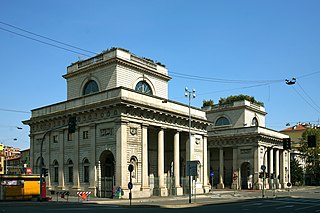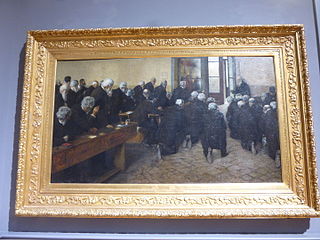External links
- Association of Ex Martinitt (in Italian)
The name Martinitt refers to a historical boy orphanage of Milan, Italy, that was established in the 16th Century, now part of Pio Albergo Trivulzio, a public Milanese institution that provides aid to needy orphans, elders and other people experiencing social difficulties. The name comes from Saint Martin, as the orphanage was originally based in the eponymous oratory. The orphan boys themselves were thus referred to as Martinitt, a plural of Martinett ("little Martin") in Lombard language. [1] The Martinitt played an important role in the history of Milan, most notably in the Five Days of Milan.
The Martinitt orphanage was founded by Gerolamo Emiliani, who had previously created an orphanage for the poor in Venice. In 1528, Duke Francesco II Sforza of Milan decided to transfer to Emiliani the oratory of Saint Martin, located in the very centre of Milan (now Via Manzoni), to be used as Milan's orphanage. Federico Borromeo later decided to give out another building, the "Spedale dei Mendicanti" ("beggars' hospital"), which was used for orphan girls. The orphan boys were called Martinitt, while the orphan girls were called Stelline.
In 1776, Empress Maria Theresa moved the orphanage to Gessate, east of Milan. At the same time, it was decided that the orphans would be housed in the orphanage until the age of 18, and that they would be taught a job.
In 1796, when Napoleone Bonaparte conquered Milan, he transformed the orphanage in a military hospital. The Martinitt then moved again, first in some buildings in Brera, then in an abandoned convent, and finally (1803) back to their original seat in Via Manzoni. In 1848, during the Five Days of Milan (when the Milanese population rebelled against the Austrian rule), the Martinitt contributed to the success of the Milanese serving as couriers, bringing dispatches from barricade to barricade.
In 1932, a new seat for the Martinitt was established by Benito Mussolini in Via Pitteri, near Lambrate.
Today, the Martinitt (and the Stelline orphanage for girls) have merged into a wider social care institution called Pio Albergo Trivulzio. [2] A museum dedicated to the history of the Martinitt and the Stelline has been established in 2009 in Corso Magenta 57, in the building next to the "Stelline Palace" (the original seat of the Stelline orphanage). [3]

Monza is a city and comune on the River Lambro, a tributary of the Po in the Lombardy region of Italy, about 15 kilometres north-northeast of Milan. It is the capital of the Province of Monza and Brianza. Monza is best known for its Grand Prix motor racing circuit, the Autodromo Nazionale di Monza, which hosts the Formula One Italian Grand Prix with a massive Italian support tifosi for the Ferrari team.

Milan Cathedral, or Metropolitan Cathedral-Basilica of the Nativity of Saint Mary is the cathedral church of Milan, Lombardy, Italy. Dedicated to the Nativity of St Mary, it is the seat of the Archbishop of Milan, currently Archbishop Mario Delpini.

Lecco is a city of 48,131 inhabitants in Lombardy, northern Italy, 50 kilometres (31 mi) north of Milan.It lies at the end of the south-eastern branch of Lake Como. The Bergamo Alps rise to the north and east, cut through by the Valsassina of which Lecco marks the southern end.

Gerolamo Emiliani was an Italian humanitarian, founder of the Somaschi Fathers, and is considered a saint by the Catholic church. He was canonized in 1767 and is the patron saint of orphans.

The Golden Ambrosian Republic was a short-lived government founded in Milan by members of the University of Pavia with popular support, during the first phase of the Milanese War of Succession. With the aid of Francesco Sforza they held out against the forces of the Republic of Venice, but after a betrayal Sforza defected and captured Milan to become Duke himself, abolishing the Republic.

Bianchi motorcycles were made from 1897 to 1967 by F.I.V. Edoardo Bianchi S.p.A., a company which today is a major Italian bicycle manufacturer, and who also produced automobiles from 1900 to 1939. Edoardo Bianchi started his bicycle manufacturing business in a small shop on Milan's Via Nirone in 1885. Bianchi was a prominent name in the motorcycle racing world from 1925 to 1930.

The Policlinico of Milan also known as Ospedale Maggiore di Milano or Ca' Granda Ospedale Maggiore Policlinico, is one of the oldest hospitals in Italy, founded by Duke Francesco Sforza in 1456. Today it is a modern hospital with 900 beds, with wards for adults, pregnant women and children. During the first COVID-19 breakout in March of 2020, 300 of those beds were readapted for COVID-19 patients.
Naples American High School is a high school within the Department of Defense Education Activity system. It is located in Campania, Italy.

Having been ruled by several countries over the years, Milanese culture is eclectic and borrows elements from other countries, including Austria, Spain and France. Similarities between these places and Milan can be noticed through the language, architecture, cuisine and general culture of these countries. In the 18th century, Austrian rule stimulated much of the city's cultural, political, social and economic life, resulting in the founding of numerous important artistic institutions, as well as contributing to the city's architecture. After the unification of Italy in 1861, Milan became a major industrial and cultural centre in the new Kingdom; in the late 19th century onwards, the city held the position of the country's economic capital, whilst Rome was the seat of the government, making it the country's main political and administrative hub. In the fin-de-siècle period and the early 20th century, the city became an important architectural centre, and remained a prominent city with regard to a major intellectual scene. After World War II, Milan was highly affected by the Italian economic miracle, or il boom, and attracted a wave of immigrants from Southern Italy, who sought work in the prosperous city. By then an important centre for finance and design, the metropolis grew into a major fashion capital in the 1980s. In the 2000s Milan still remains one of the country's most important cultural, media and economic centres, regarded as the nation's second city; its prominence is extended worldwide, and it is recognised as an Alpha global city. The city additionally hosted the Expo 2015. Milan is traditionally referred to as the moral capital of Italy, especially due to the city's perceived work ethic.

Villas and palaces in Milan are used to indicate public and private buildings in Milan of particular artistic and architectural value. Milan has always been an important centre with regard to the construction of historical villas and palaces, ranging from the Romanesque to the neo-Gothic, from Baroque to Rococo.

Porta Venezia is one of the historical gates of the city of Milan, Italy. In its present form, the gate dates back to the 19th century; nevertheless, its origins can be traced back to the Medieval and even the Roman walls of the city.

The Oratorio di San Protaso is a church in via Lorenteggio, Milan, Lombardy.

The Pio Albergo Trivulzio, formally Azienda di servizi alla persona Istituti Milanesi Martinitt e Stelline e Pio Albergo Trivulzio, commonly referred to as Baggina, is an ancient retirement home and hospital in Milan, Italy. Still active today, it dates back to 1766.

The Zone 1 of Milan, since 2016 officially Municipality 1 of Milan, is one of the 9 administrative administrative divisions of Milan, Italy.
The Institute of the Sisters of Charity of Saints Bartolomea Capitanio and Vincenza Gerosa (SCCG) also known as the Sisters of Maria Bambina had its origins in a house which the people called "Conventino" in Lovere, Italy. It was founded by a young woman of 26 named Bartolomea Capitanio in 1832. Bartolomea was helped in her project by Catherine Gerosa, a simple and wealthy lady of Lovere who later took the name of Sister Vincenza, in honor of St. Vincent de Paul.
San Francesco di Paola is a Baroque style, Roman Catholic church located on Via Manzoni in Milan, Italy.
The Villa Litta Modignani is a 17th-century rural palace and park located on Via Taccioli in the north suburbs of Milan, in the Province of Milan, Lombardy, Italy.
Caterina Cittadini was an Italian Roman Catholic religious from Bergamo who established the Ursuline Sisters of Saint Jerome Emiliani. The order was dedicated to the education of girls in Bergamo and in the surrounding areas and has since expanded outside of the Italian nation. Cittadini was orphaned as a child and cultivated her faith among fellow children in an orphanage where the spiritual direction was strong. Her order came in part of her devotion to Saint Jerome Emiliani as well as the Blessed Mother.

Gian Giacomo Poldi Pezzoli was an Italian count who gathered art from Italian Renaissance and left Italy one of the first private museum which bears his name, the Museo Poldi Pezzoli.